Prediction of Abdominal Aortic Aneurysm Growth Using Dynamical Gaussian Process Implicit Surface
- PMID: 29993480
- PMCID: PMC6414317
- DOI: 10.1109/TBME.2018.2852306
Prediction of Abdominal Aortic Aneurysm Growth Using Dynamical Gaussian Process Implicit Surface
Abstract
Objective: We propose a novel approach to predict the Abdominal Aortic Aneurysm (AAA) growth in future time, using longitudinal computer tomography (CT) scans of AAAs that are captured at different times in a patient-specific way.
Methods: We adopt a formulation that considers a surface of the AAA as a manifold embedded in a scalar field over the three dimensional (3D) space. For this formulation, we develop our Dynamical Gaussian Process Implicit Surface (DGPIS) model based on observed surfaces of 3D AAAs as visible variables while the scalar fields are hidden. In particular, we use Gaussian process regression to construct the field as an observation model from CT training image data. We then learn a dynamic model to represent the evolution of the field. Finally, we derive the predicted AAA surface from the predicted field along with uncertainty quantified in future time.
Results: A dataset of 7 subjects (4-7 scans) was collected and used to evaluate the proposed method by comparing its prediction Hausdorff distance errors against those of simple extrapolation. In addition, we evaluate the prediction results with respect to a conventional shape analysis technique such as Principal Component Analysis (PCA). All comparative results show the superior prediction performance of the proposed approach.
Conclusion: We introduce a novel approach to predict the AAA growth and its predicted uncertainty in future time, using longitudinal CT scans in a patient-specific fashion.
Significance: The capability to predict the AAA shape and its confidence region by our approach establish the potential for guiding clinicians with informed decision in conducting medical treatment and monitoring of AAAs.
Figures

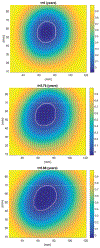
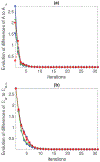




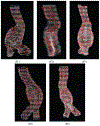
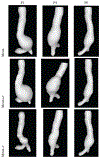
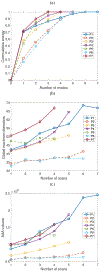


Similar articles
-
Beyond fusiform and saccular: a novel quantitative tortuosity index may help classify aneurysm shape and predict aneurysm rupture potential.Ann Vasc Surg. 2008 Jan;22(1):88-97. doi: 10.1016/j.avsg.2007.09.004. Epub 2007 Nov 26. Ann Vasc Surg. 2008. PMID: 18023556
-
3D segmentation of abdominal aorta from CT-scan and MR images.Comput Med Imaging Graph. 2012 Jun;36(4):294-303. doi: 10.1016/j.compmedimag.2011.12.001. Epub 2012 Jan 17. Comput Med Imaging Graph. 2012. PMID: 22257909
-
In vivo analysis of mechanical wall stress and abdominal aortic aneurysm rupture risk.J Vasc Surg. 2002 Sep;36(3):589-97. doi: 10.1067/mva.2002.125478. J Vasc Surg. 2002. PMID: 12218986
-
Anatomic characteristics of ruptured abdominal aortic aneurysm on conventional CT scans: Implications for rupture risk.J Vasc Surg. 2004 Jun;39(6):1243-52. doi: 10.1016/j.jvs.2004.02.025. J Vasc Surg. 2004. PMID: 15192565
-
Isotropic 3D black blood MRI of abdominal aortic aneurysm wall and intraluminal thrombus.Magn Reson Imaging. 2016 Jan;34(1):18-25. doi: 10.1016/j.mri.2015.10.002. Epub 2015 Oct 22. Magn Reson Imaging. 2016. PMID: 26471514 Free PMC article.
Cited by
-
Automated Screening for Abdominal Aortic Aneurysm in CT Scans under Clinical Conditions Using Deep Learning.Diagnostics (Basel). 2021 Nov 17;11(11):2131. doi: 10.3390/diagnostics11112131. Diagnostics (Basel). 2021. PMID: 34829478 Free PMC article.
-
Reconstructing blood flow in data-poor regimes: a vasculature network kernel for Gaussian process regression.J R Soc Interface. 2024 Aug;21(217):20240194. doi: 10.1098/rsif.2024.0194. Epub 2024 Aug 22. J R Soc Interface. 2024. PMID: 39173147 Free PMC article.
-
Patient-Specific Prediction of Abdominal Aortic Aneurysm Expansion Using Bayesian Calibration.IEEE J Biomed Health Inform. 2019 Nov;23(6):2537-2550. doi: 10.1109/JBHI.2019.2896034. Epub 2019 Jan 30. IEEE J Biomed Health Inform. 2019. PMID: 30714936 Free PMC article.
-
Clinical applications of machine learning in predicting 3D shapes of the human body: a systematic review.BMC Bioinformatics. 2022 Oct 17;23(1):431. doi: 10.1186/s12859-022-04979-2. BMC Bioinformatics. 2022. PMID: 36253726 Free PMC article.
-
Machine learning approaches to surrogate multifidelity Growth and Remodeling models for efficient abdominal aortic aneurysmal applications.Comput Biol Med. 2021 Jun;133:104394. doi: 10.1016/j.compbiomed.2021.104394. Epub 2021 Apr 15. Comput Biol Med. 2021. PMID: 34015599 Free PMC article.
References
-
- Porth CM, Essentials of pathophysiology: Concepts of altered health states. Lippincott Williams & Wilkins, 2010.
-
- Zankl AR, Schumacher H, Krumsdorf U, Katus HA, Jahn L et al., “Pathology, natural history and treatment of abdominal aortic aneurysms,” Clinical Research in Cardiology, vol. 96, no. 3, pp. 140–151, 2007. - PubMed
-
- Klink A, Hyafil F, Rudd J, Faries P, Fuster V, Mallat Z, Meilhac O, Mulder WJ, Michel J-B, Ramirez F et al., “Diagnostic and thera-peutic strategies for small abdominal aortic aneurysms,” Nature Reviews Cardiology, vol. 8, no. 6, pp. 338–347, 2011. - PubMed
-
- Kniemeyer H, Kessler T, Reber PU, Ris HB, Hakki H, and Widmer MK, “Treatment of ruptured abdominal aortic aneurysm, a permanent challenge or a waste of resources? prediction of outcome using a multi-organ-dysfunction score,” European Journal of Vascular and Endovascular Surgery, pp. 190–196, 2000. - PubMed
Publication types
MeSH terms
Grants and funding
LinkOut - more resources
Full Text Sources
Other Literature Sources

